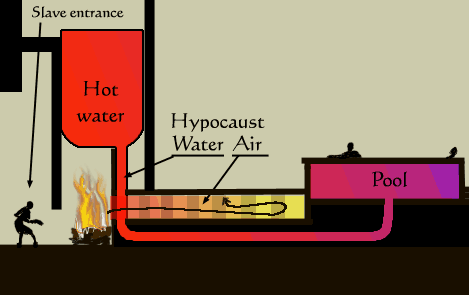Hypocausts: Heating Homes In Ancient Rome

Hypocausts: Heating Homes In Ancient Rome
Romans used a combination of Greek and Phoenician style of architecture to built bridges, temples, arches, harbours, palaces, baths, domes and vaults, and used innovative concrete to build public buildings. Even today the architecture and design of Constantine, Pantheon, and Pont du Gard appears outstanding and it ensures the durability of material used in the construction. Ancient Roman architecture shows how it provided long lasting residential which was equipped with piped water (Pompei) and double glazing (Ostia Antica). The scheme of dome construction of the Baths of Diocletian and the Baths of Caracalla provided cheap cover on public baths and basilicas.
Hypocausts Aspects
The ancient building and baths were designed in a way to be suitable for the masses. The houses built in ancient Rome were mainly designed to provide public hygiene which included the private baths and the latrines, and the system of under floor heating through hypocaust. Hypocaust was used in ancient Roman public baths and private houses. The word hypocaust means “fire beneath” in Greek. The design of hypocaust was made by raising the floor above the ground using pillars and a layer of tiles was used above the layer of concrete, and spaces were left in the design inside the walls to allow hot air and smoke to pass through the enclosed area, and get out of the roof which heated the interior of the room and it also expelled the smoke out. Ceramic box tiles were used to remove the hot air.
The rooms which required more heat were located close to the furnace and wood was added regularly to create the fire. Since the system required a person to constantly tend the fire – it was expensive system which was used only in public baths and villas. The Romans constructed the system to be able to run the public baths efficiently. Before the construction of hypocaust, a kind of single fire hearth was used for heating the homes. Hearth was situated in the middle of the house and it was also used for cooking. Other than hypocausts, Kachelofen was used for heating, and it was hot stoves which captured heat and released it into the room.
House Heating
Hypocausts the Bottomline
In modern era, you can see fan-assisted heaters or ACs are used for central heating system. Gas or electricity is used for heating water or water is heated in a boiler or in a loft. Hypocausts were also popular in 1960s in UK and electric supply was used to run the system. But it is very expensive to manage hypocausts as you have to keep the fire burning using wood or electricity, and even with electricity the cost was high. In 1960s, the electricity based hypocausts sometimes did not deliver the desired output. Nowadays, the general heating system is based on the concept of under floor heating of hypocausts and electric under floor heating can be commonly seen in households in UK which comes with home extensions, bathrooms and conservations. In the new system, the manufacturer use thermal floor insulation to provide improved central heating.
in the middle of the house and it was also used for cooking. Other than hypocausts, Kachelofen was used for heating, and it was hot stoves which captured heat and released it into the room.









